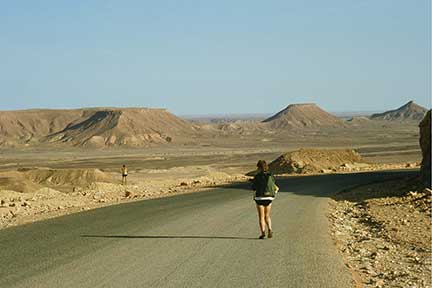Some Notes on the Sahara
Here in the civilized, sophisticated world, the air around us is never still. We have forgotten—if indeed we ever knew—what silence is. Even when we think we have found it we are, like as not, subconsciously shutting our ears to the sounds of nature—the rustle of branches, the trickle of water, the cry of a distant animal. In the open desert, even these sounds are exceptions; silence stands no longer as a negative concept but as a positive, present thing, wrapping itself round you like a cloak. —John Julius Norwich
- The Sahara is 5,000 kilometers across, and is the size of the entire United States.
- The continent of Australia could fit inside it with large areas left over.
- It is possible to drive 175 kilometers a day for three days and see absolutely no vegetation.
- Some Sahara sand dunes cover more area than the country of England.
- A desert by definition receives less than 250 mm of rain a year. 80% of the Sahara receives less than 100 mm a year.
- In some places it has not rained in over 20 years.
- The average daily maximum temperature in the summer is 115 degrees Fahrenheit. Temperatures of 120 degrees are not uncommon. The highest temperature recorded on earth was in Libya—136 degrees!
- In some places the temperature range can be as much as 85 degrees from high to low in a single day.
- Camels were imported from Asia when the Sahara became too dry for horses. Camel feet spread to provide flotation on the sand. Camels can adjust the volume of their vascular system when dehydrating and sweat only 1/1000th of their body weight.
- There are special blood vessels at the base of a camel's brain to keep it cool even when the body is heated to 115 degrees Fahrenheit. Camels can stand up to 1.8% salt in water (enough to kill a man), and even have a limited ability to combine hydrogen with oxygen in the air to make water!
- As recently as 1905, there were twice yearly salt caravans from North Africa to Timbuktu with 12,000 camels, each carrying 4 blocks of salt weighing 100 pounds each.
- Even when it rains, there can be problems. The average annual rainfall in Tamanrasset is 41 mm. One day in September 1950, it rained 44 mm in three hours, causing extensive erosion. When it rains, it pours.
- A man can sweat up to 3 liters an hour in the Sahara—up to 10% of body weight a day. Sweat evaporates immediately without even moistening the skin.
- Saharan dust and the wholesale burning of the continent's forests make Africa the major producer of particulate matter in earth's atmosphere.
 Take a close look at the photo to the tight. Can you see the Exodus truck? It's to the right of the hill at the bottom. It looks teeny tiny, but it isn't!
Take a close look at the photo to the tight. Can you see the Exodus truck? It's to the right of the hill at the bottom. It looks teeny tiny, but it isn't!
Go on to Hogar Mountains Landrover Expedition
Source: www.SusanCAnthony.com, ©Susan C. Anthony

